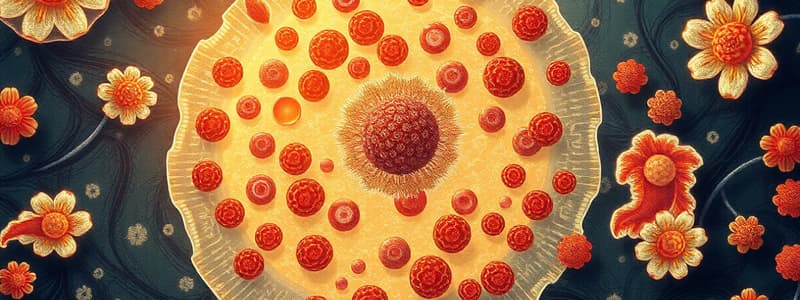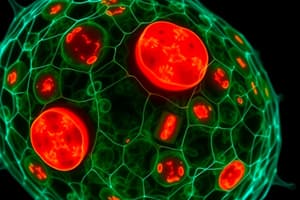Podcast
Questions and Answers
What is the primary function of peroxisomes in a cell?
What is the primary function of peroxisomes in a cell?
- To synthesize nucleotides
- To oxidize toxic substances (correct)
- To produce ribosomes
- To store cellular waste
Which of the following correctly describes ribosomes?
Which of the following correctly describes ribosomes?
- Involved in lipid synthesis
- Small complexes synthesized by the nucleolus (correct)
- Organelles that store genetic material
- Large membrane-bound organelles
How is hydrogen peroxide (H2O2) treated by peroxisomes?
How is hydrogen peroxide (H2O2) treated by peroxisomes?
- Incorporated into proteins
- Converted into glucose
- Broken down into water and oxygen (correct)
- Stored for later use
Where are ribosomes primarily synthesized within the cell?
Where are ribosomes primarily synthesized within the cell?
Which of the following substances do peroxisomes specifically oxidize?
Which of the following substances do peroxisomes specifically oxidize?
Which of the following best describes the primary function of smooth endoplasmic reticulum (ER) in specific cell types?
Which of the following best describes the primary function of smooth endoplasmic reticulum (ER) in specific cell types?
In which cells would you expect a high abundance of smooth ER due to lipid production?
In which cells would you expect a high abundance of smooth ER due to lipid production?
What type of hormones are primarily produced by the smooth ER in the adrenal gland cortex?
What type of hormones are primarily produced by the smooth ER in the adrenal gland cortex?
What is the primary function of ribosomes mentioned in the content?
What is the primary function of ribosomes mentioned in the content?
Which statement about the smooth ER is NOT true?
Which statement about the smooth ER is NOT true?
What structural components make up the Golgi apparatus?
What structural components make up the Golgi apparatus?
What distinguishes smooth ER from rough ER in terms of function?
What distinguishes smooth ER from rough ER in terms of function?
How do the proteins reach the Golgi apparatus for modification?
How do the proteins reach the Golgi apparatus for modification?
What role do enzymes play within the Golgi apparatus?
What role do enzymes play within the Golgi apparatus?
Which statement regarding intracellular proteins is true based on the provided content?
Which statement regarding intracellular proteins is true based on the provided content?
What is the primary role of proteins attached to the endoplasmic reticulum (ER)?
What is the primary role of proteins attached to the endoplasmic reticulum (ER)?
In what structural form do free ribosomes typically exist within the cytoplasm?
In what structural form do free ribosomes typically exist within the cytoplasm?
Which statement accurately describes secretory proteins?
Which statement accurately describes secretory proteins?
What is a common misconception about ribosomes found in the cytoplasm?
What is a common misconception about ribosomes found in the cytoplasm?
Which of the following is NOT true regarding polymers of ribosomes?
Which of the following is NOT true regarding polymers of ribosomes?
Which statement accurately describes the process of autodigestion in cells?
Which statement accurately describes the process of autodigestion in cells?
How do peroxisomes differ from traditional lysosomes in their function?
How do peroxisomes differ from traditional lysosomes in their function?
What would happen if a cell lacked functional lysosomes?
What would happen if a cell lacked functional lysosomes?
In what way do oxidative enzymes in peroxisomes contribute to cellular health?
In what way do oxidative enzymes in peroxisomes contribute to cellular health?
What primary role do centrioles play during cell division?
What primary role do centrioles play during cell division?
In addition to their role in cell division, what do centrioles give rise to?
In addition to their role in cell division, what do centrioles give rise to?
Which of the following statements about centrioles is correct?
Which of the following statements about centrioles is correct?
During cell division, which cellular structure directly interacts with centrioles?
During cell division, which cellular structure directly interacts with centrioles?
What happens to centrioles during the process of cell division?
What happens to centrioles during the process of cell division?
Flashcards
What is the role of the smooth ER in lipid production?
What is the role of the smooth ER in lipid production?
The smooth endoplasmic reticulum (SER) is involved in the synthesis of lipids, including steroid hormones.
What are steroid hormones?
What are steroid hormones?
Steroid hormones are a class of hormones that are lipid-based and play crucial roles in various biological processes.
Why is smooth ER abundant in the testes and adrenal gland cortex?
Why is smooth ER abundant in the testes and adrenal gland cortex?
Steroid hormones are produced by the smooth ER in cells of the testes and adrenal gland cortex, which are both involved in hormone production.
What are some examples of steroid hormones?
What are some examples of steroid hormones?
Signup and view all the flashcards
What is the smooth ER?
What is the smooth ER?
Signup and view all the flashcards
Peroxisomes
Peroxisomes
Signup and view all the flashcards
Hydrogen Peroxide (H2O2)
Hydrogen Peroxide (H2O2)
Signup and view all the flashcards
Ribosomes
Ribosomes
Signup and view all the flashcards
Nucleolus
Nucleolus
Signup and view all the flashcards
Protein Synthesis
Protein Synthesis
Signup and view all the flashcards
ER-Bound Ribosomes
ER-Bound Ribosomes
Signup and view all the flashcards
Free Ribosomes & Polysomes
Free Ribosomes & Polysomes
Signup and view all the flashcards
Secretory Proteins
Secretory Proteins
Signup and view all the flashcards
Polysome
Polysome
Signup and view all the flashcards
Polysome Formation
Polysome Formation
Signup and view all the flashcards
What are intracellular proteins?
What are intracellular proteins?
Signup and view all the flashcards
What is the Golgi apparatus?
What is the Golgi apparatus?
Signup and view all the flashcards
How does the Golgi apparatus modify proteins?
How does the Golgi apparatus modify proteins?
Signup and view all the flashcards
What happens to proteins after they've been modified by the Golgi apparatus?
What happens to proteins after they've been modified by the Golgi apparatus?
Signup and view all the flashcards
Why is the Golgi apparatus important for hormone production?
Why is the Golgi apparatus important for hormone production?
Signup and view all the flashcards
Catalase
Catalase
Signup and view all the flashcards
What are centrioles?
What are centrioles?
Signup and view all the flashcards
Detoxification
Detoxification
Signup and view all the flashcards
Oxidation
Oxidation
Signup and view all the flashcards
How do centrioles participate in cell division?
How do centrioles participate in cell division?
Signup and view all the flashcards
How do centrioles contribute to cilia and flagella formation?
How do centrioles contribute to cilia and flagella formation?
Signup and view all the flashcards
What are cilia?
What are cilia?
Signup and view all the flashcards
What are flagella?
What are flagella?
Signup and view all the flashcards
Study Notes
Cell Structure and Function
- Cells are the basic units of life, and their structure and function are highly specialized.
- The cell is enclosed by a plasma membrane, which regulates what enters and exits the cell.
- Cells have various organelles that carry out specific functions.
- The endoplasmic reticulum is composed of interconnected membranes.
- Rough ER: studded with ribosomes, involved in protein synthesis.
- Smooth ER: lacks ribosomes, synthesizes lipids and detoxifies harmful substances.
- Ribosomes: responsible for protein synthesis.
- Free ribosomes synthesize proteins used in the cytoplasm.
- Bound ribosomes synthesize proteins destined for export or insertion into membranes.
- Golgi apparatus: modifies, sorts, and packages proteins and lipids for secretion or use within the cell.
- Modifies proteins and lipids.
- Lysosomes: membrane-bound sacs containing digestive enzymes; involved in breakdown of macromolecules.
- Digest macromolecules within the cell.
- Mitochondria: the "powerhouses" of the cell; generate ATP through cellular respiration.
- Cytoskeleton: network of protein fibers that supports the cell structure.
- Microfilaments: thin fibers, crucial for cell movement and support.
- Microtubules: larger fibers, essential for cell shape and movement.
- The nucleus: control center of the cell.
- Contains DNA organized into chromosomes.
- Surrounded by a double membrane (nuclear envelope).
- Contains nucleolus, which synthesizes ribosomes.
- Centrioles: involved in cell division.
- Aid in the organization of microtubules during cell division.
- Cilia and flagella: hair-like structures extending from the cell.
- Assist in cell movement.
Cell Organelles - Detailed View
- Endoplasmic Reticulum: A network of membranes, continuous with the nuclear envelope.
- Rough ER: studded with ribosomes, synthesizes proteins.
- Smooth ER: lacks ribosomes, synthesizes lipids and detoxifies.
- Golgi Apparatus: Modifies, sorts, and packages proteins for secretion or use in the cell.
- Lysosomes: Contain enzymes for breaking down waste and cellular debris.
- Mitochondria: Double-membrane organelles, produce ATP (energy).
- Cytoskeleton: Provides structural support and facilitates movement.
- Microfilaments: Small fibers for movement and support.
- Microtubules: Larger fibers for cell shape and movement.
- Centrioles: Play a vital role in cell division.
- Cilia and flagella: Microscopic, hair-like structures that aid in movement.
Other Important Details
- Specific Functions of the Smooth ER: Lipid synthesis, steroid hormone production, calcium storage, detoxification of drugs and poisons.
- Function of Peroxisomes: Detoxification of harmful substances such as alcohol, hydrogen peroxide.
- Structure of Mitochondria: Contain cristae (folds in the inner membrane), critical for ATP production.
- Cytoskeleton Roles: Maintain cell shape, anchor organelles, facilitate cell movement, and cell division.
- Nucleus and Chromosomes: Nucleus contains DNA organized into chromosomes; chromosomes control the cell's activities.
- Cilia and Flagella: Help in cell movement (e.g., in sperm cells and respiratory tract).
Studying That Suits You
Use AI to generate personalized quizzes and flashcards to suit your learning preferences.




